TEAM BUFO – the second generation
Rick’s Laureate Fellowship from the Australian Research Council started in
2013, and provided another five years of funding to explore the biology of cane
toads. This time around, our focus was more defined. At the start of the
earlier round of funding (under Rick’s Federation Fellowship), we had to look
at a lot of topics, to work out what was going on. We
learnt a lot, and when Rick was awarded the Laureate
Fellowship, he could take a more focused approach. For the Laureate research, we mostly looked
at the rapid evolutionary changes in toads and their predators. This time around, our collaboration with geneticist Lee Ann Rollins was a primary theme.
The
field station at Middle Point near Darwin was still our main base, although we
also did quite a lot of work on cane toads in northeastern New South
Wales (a project led by Dr Matt Greenlees). Dr Greg Brown and Dr Michael
Crossland were still based at the field station near Fogg Dam, where they were joined by other postdocs.
Dr Jayna DeVore
Jayna is from the USA, with extensive research experience on invasion biology and American toads. Jayna conducted experiments to look at direct environmental effects on cane toad characteristics. For example, does a tadpole’s exposure to chemicals (scents) from predators affect the way it develops? Studies on other amphibian species have revealed strong effects of this type, and Jayna discovered that the same thing happens with cane toads. Interestingly, toads from different areas respond differently - in ecological terms, they speak different chemical "languages"!
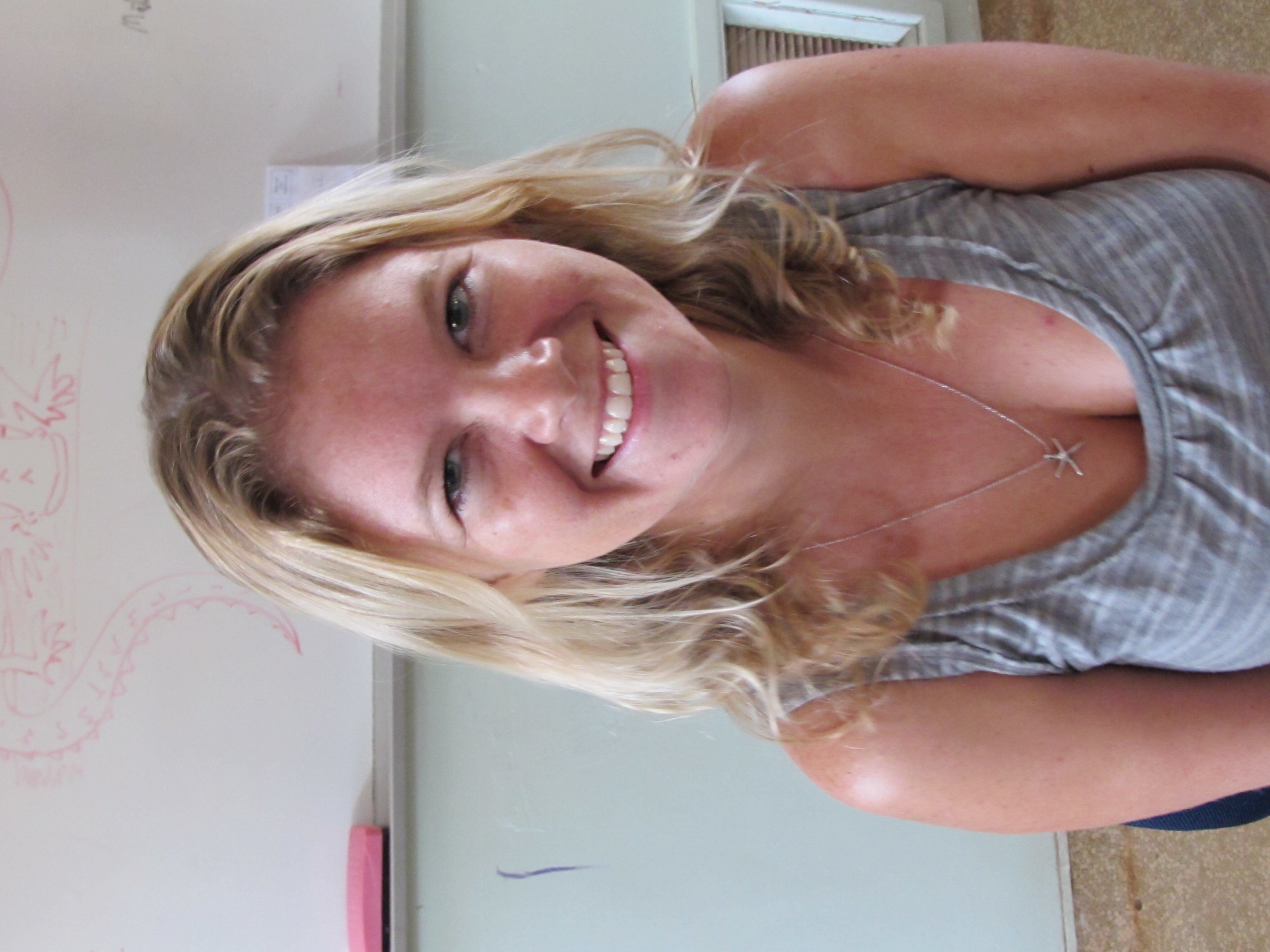
Dr Jayna DeVore looked at the
ways that local conditions affect the way that a cane toad develops. She worked out the effects of toad tadpole scent on younger tadpoles, and how the interaction between those life-stages has changed over the course of the toads' invasion of Hawai'i and Australia. Photo by Simon Ducatez.
Dr Simon Ducatez
Simon is a
French ecologist who has worked on all kinds of animals from butterflies
through to elephant seals. Simon worked closely with Michael Crossland on flexible responses of toad tadpoles to the presence of other tadpoles, and the chemicals they produce. He also worked closely with Jayna, and they embarked on an exciting field trip to French Guiana, in South America, to look at the ecology of cane toads in their native range. And not too long after that, Simon and Jayna were married to each other.
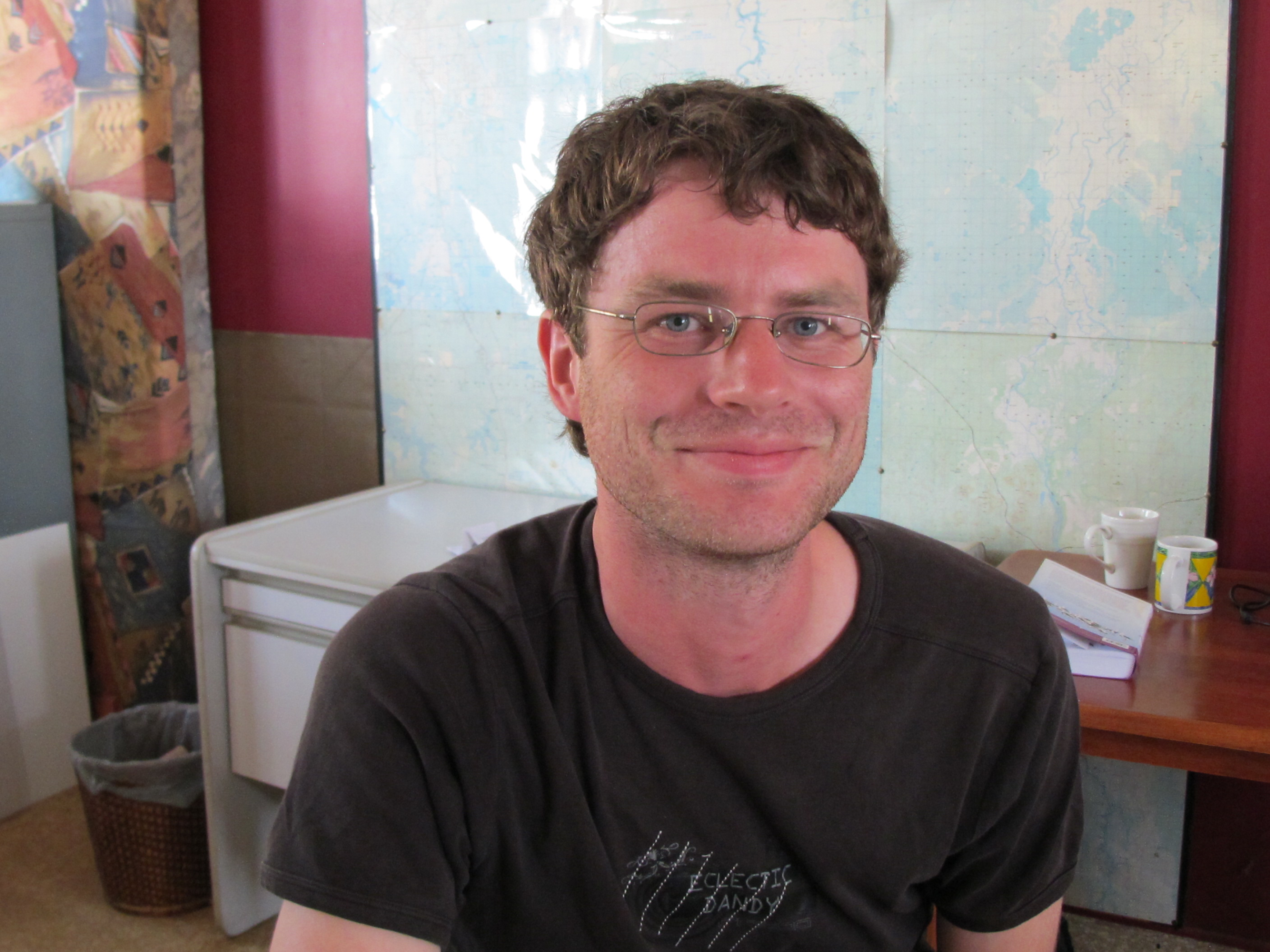
Dr Simon Ducatez studied cane toad development and evolution. Photo by Melanie Elphick
Dr Matt Greenlees
Matt was a foundation member of TEAM BUFO - first as an Honours student, then for his Ph D, and then as a postdoc taking responsibility for the southern (New South Wales) invasion front. He has worked on many projects, and supervised many students. You can read more about him in our "New South Wales research" page.

Matt has spent plenty of time in the tropics as well as down south. His trips to the Northern Territory often seem to coincide with peak barramundi fishing season. Photo by Rick Shine.
Shorter-term postdocs
Camila Both spent a year developing personality tests for toads and tadpoles.
Chris Friesen joined TEAM BUFO to study toad sex - especially sperm. He found that male toads at the invasion front have smaller sex organs (testes) than do males in the range-core. The invasion-front toads are too busy traveling to invest too much energy into mating!
Wei Chen joined us from China to look in detail at the distribution of toxin-producing glands in cane toads. He discovered that males and females have very different gland distributions - something that nobody had ever noticed before.
Mark Fuller-Richardson worked with Lee Ann Rollins on measuring patterns of gene expression in cane toads.
Collaborators
Although she is based at New South Wales University, Dr Lee Ann Rollins is a central part of TEAM BUFO. Lee Ann is an expert in the genetics of invasive species, and she (with postdoc Mark Richardson and former Ph D student Dan Selechnik) is giving us a new and exciting perspective on the genetic changes that have driven the rapid evolution of cane toads in Australia. Lee Ann spearheaded our successful attempt to sequence the genome of the cane toad.
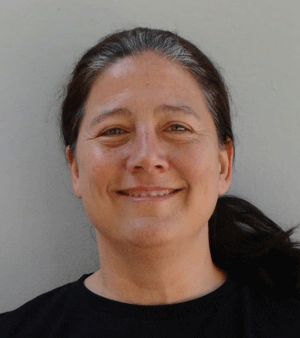
Dr Lee Ann Rollins has provided a
new dimension to TeamBufo’s research, by showing us the genetic basis of the
evolutionary changes that have occurred in Australian cane toads. Photo by Melanie Elphick.
Professor Keith Christian at Charles Darwin University, in Darwin, has worked with TEAM BUFO over many years. He has studied toad physiology and more recently, the ecological function of toad skin secretions as a barrier to infection by parasites.
Professor Martin Whiting from Macquarie University is working With TEAM BUFO on brain structure and function in toads. Indeed, brains and behavior are emerging as major themes of our research. We want to know not just what toads look like, but also how they think and how they behave.
Graduate students
Along with the postdocs, we took on a new cohort of Ph D students and Honours students. Uditha Wijethunga came to Sydney from Sri Lanka, and investigated adaptation in toads along the southern front in New South Wales. Under Matt’s supervision, Uditha looked at issues such as the toad’s ability to handle variable conditions of salinity and pH, as well as their interactions with predators.
The other Ph D students were mostly based in the tropics. Georgia Ward-Fear returned to TEAM BUFO after doing her Honours work at Fogg Dam (on meat ants and cane toads) a few years previously. She looked at goannas and toads in the Kimberley region.
Cameron Hudson studied the evolution of cane
toad size, shape and locomotion for his Ph. D., and was based at Fogg Dam
most of the time. We knew that the toads have evolved to move faster and faster
during their time in Australia, and Cam worked out exactly how they have
done it. Another Ph D student at Fogg Dam, Jodie Gruber, asked the same
kinds of questions about cane toad behaviour. Jodie developed
personality tests for toads, so she could compare the ones at the invasion front to toads in long-colonised areas. Sure enough, they are different - and their offspring inherit those differences.
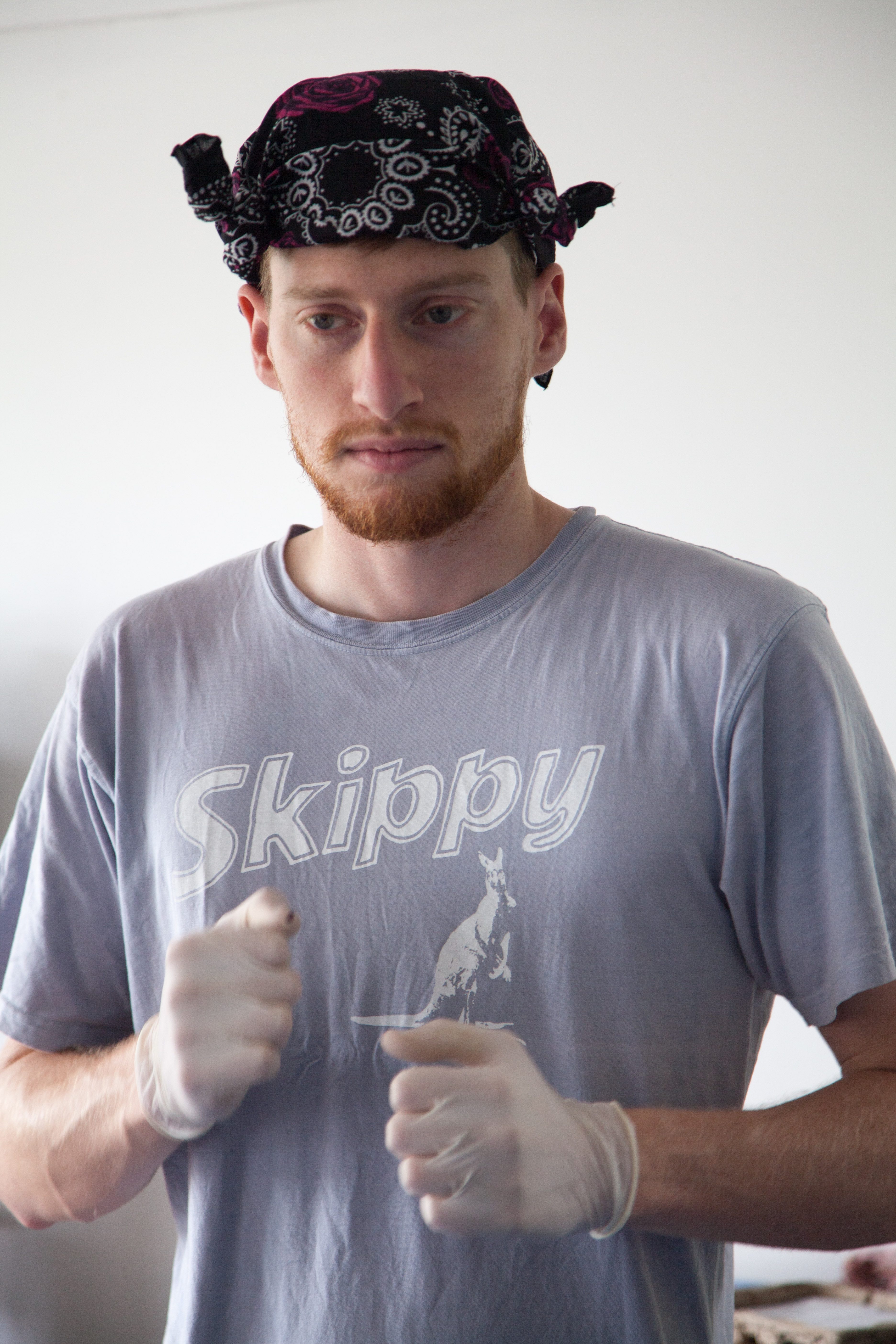
For his Ph D, Cam Hudson measured literally thousands of cane toads, from across the world. Photo by Terri Shine.
Georgia Kosmala from Brazil worked on the way that toads are affected by temperature and moisture loss - for example, how does it affect their ability to move around? Co-supervised by Prof Keith Christian at Charles Darwin University, Georgia found big differences among toads from different areas.
Sam McCann also stayed with TEAM BUFO after her Honours year, and looked at ways to translate our laboratory work on tadpole control into the field. That involved some very ambitious field experiments, including constructing a large series of pools in the Kimberley.
Dan Selechnik took on the challenge of measuring gene expression, under Lee Ann Rollins' co-supervision. Dan found strong shifts in gene expression in the course of the toad invasion, supporting our work on physical and behavioural changes.
Greg Clarke was co-supervised by Ben Phillips for his work on competition between tadpoles, and between young toads. It's clear that competitive ability, like so many other traits, has changed during the toads' Australian adventure.
Lachlan Pettit took on an incredibly ambitious task - to drive thousands of kilometres across northern and eastern Australia, across the entire invaded range of toads, to see how the numbers and behaviour of goannas have changed over the long term.
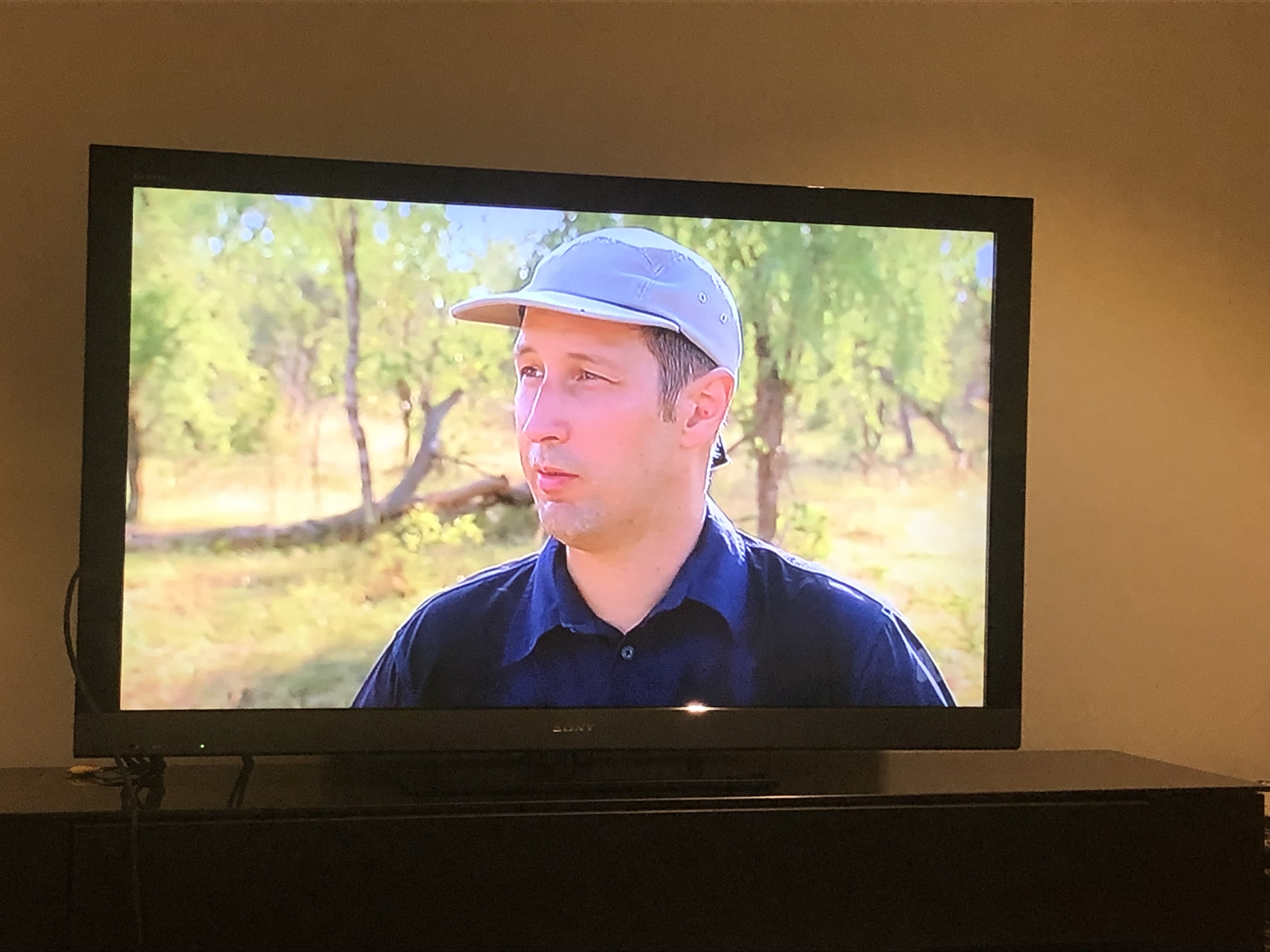
Public interest in cane toads means that even the students of TEAM BUFO have learned how to present stories on TV. In this photo of a TV screen, Lachlan Pettit is talking about his research.
After Rick shifted his base to Macquarie University, Masters student Lincoln McGregor studied toads in new South Wales. Lincoln tested different methods of finding toads (including eDNA approaches, with Mark DeBruyn), and carefully assembled a huge information base to plot the toads' southwards expansion into New South Wales.
Another
Masters student at Macquarie Uni, Shannon Kaiser, looked at the effects
of the intense 2019 wildfires on the ecology of toads in northeastern
New South Wales. Toads are tough; the fires don't seem to have slowed down their southern advance.
Honours students
The impact of cane toads in southern Australia was the main project for Honours student Chris Jolly, with an emphasis on large goannas . Chris found that toad invasion can be devastating for goannas in southern Australia, as it is in the tropics. However, younger lizards were more cautious than older ones, and so the youngsters were more likely to survive after toads arrived.
Felicity Nelson joined us in 2013 to pursue an increasingly important theme in our work - the interaction between cane toads and their parasites. Felicity looked at native frogs as well as toads. Fortunately, the toad lungworm doesn't easily cross to most Australian frogs. Otherwise, it could have been a disaster.
Damian Holden looked at a related topic - the immune response of toads, and how it has changed during their Australian invasion.
Camilla
Raven spent 2015 exploring the behaviour of toad tadpoles. What makes
them seek out each other's company, forming dense swarms? Camilla found
that tadpoles are good at detecting their relatives, and joining them if
they see feeding behaviour. Not bad for an animal with a brain the size
of a pinhead!
Lachlan Pettit's study was based in northern NSW, and addressed an interesting question: how does a toad behave if you catch it and move it to a new area? This is basically what happens with "stowaway" toads, that catch a ride in a truck ... do they wander extensively after they reach their new home? This would have strong implications for the movements, and hence impact, of toads that are brought to places like Sydney. Sure enough, Lachlan found that the translocated toads were very mobile.
Renee Silvester addressed another classic question. Ever since cane toads began spreading through Australia, bee-keepers have complained that the toads are eating their bees - and so, may cause economic damage as well as interfering with plant-pollination rates and so forth. Renee set up her own hives in northern NSW, and tracked toads around them. Sure enough, toads gathered at night to eat bees - sometimes the toads stood on each other's backs to reach high enough to get at the insects! But excluding toads from hives didn't affect honey production, so it seems that toads don't eat enough bees eaten to be a problem.
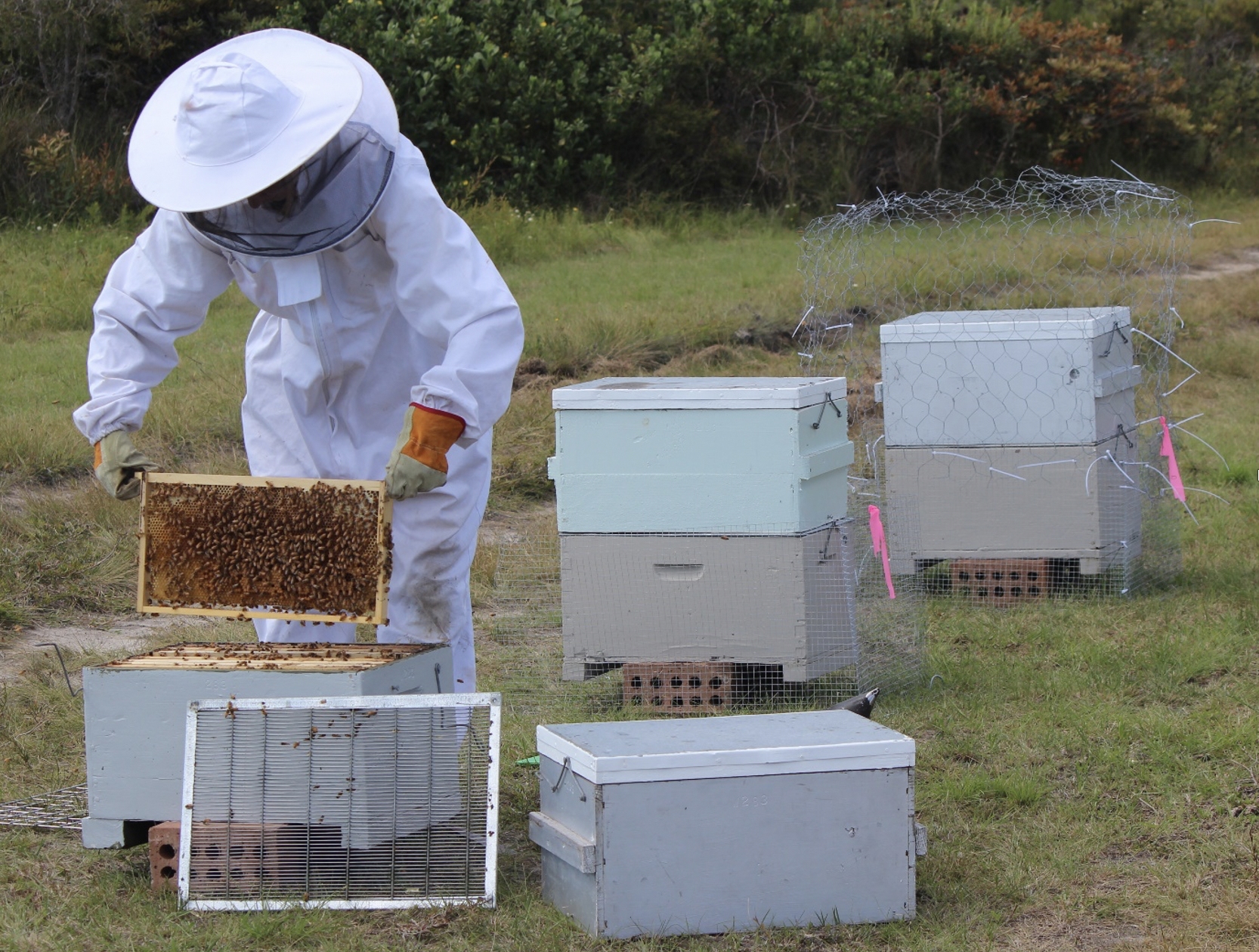
Renee Silvester's Honours project on effects of cane toads on beehives required great care and protective equipment. Photo by Matt Greenlees.
Back at Fogg Dam, Patt Finnerty's Honours in 2016 was an ambitious experiment to measure the impact of lungworm parasites on toads. It was a very dry year, and the toads were already in trouble. Toads that were freed from their lungworms (by being given a drug) were more likely to survive, and were more active. And remarkably, the lungworm can manipulate its host's behaviour and physiology. Infected toads produced watery poo, close to the pond - a great start in life for a baby lungworm!
Kat Stuart was also based at Fogg Dam. For her Honours year, she raised baby toads from different populations, and exposed them to different treatments - like different diets, and exercise - to see how their bodies responded. She showed that the differences between toads from different regions are partly due to genetics, partly due to early life experiences, and partly due to a combination of those two factors - that is, "nature" plus "nurture".
And in 2020, Abhilasha Aiyer did her Honours in the Kimberley under Georgia Ward-Fear's supervision. Abhi looked at the behaviour of freshwater crocodiles in the wild, and developed a method to expose free-ranging crocs to baits (toad legs) that taught the animals not to eat cane toads.
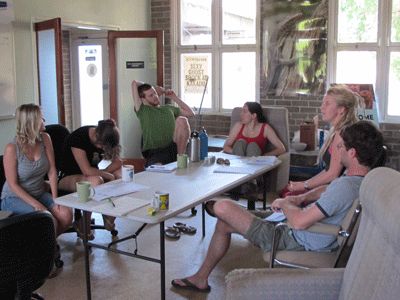
The second generation of Team Bufo, discussing toad biology (what else?) in our field station. Photo by Rick Shine.
Because the development of a cane toad is affected by the local environment (a process that we now understand much better!), we can't just directly compare toads caught at the invasion front to those from other areas. Any differences that we see might just be due to the effects of the local environment (such as food supply, or density of other toads), not to evolved (genetic) traits. So we bred adult toads from different areas, and raised their offspring under identical conditions at Fogg Dam. That way, we could study the babies as they grow up, and reliably identify genetically-based (evolved) differences. Many such differences turned up in our data. And so, we can understand how cane toads have evolved during their invasion of Australia.
Return to Home Page
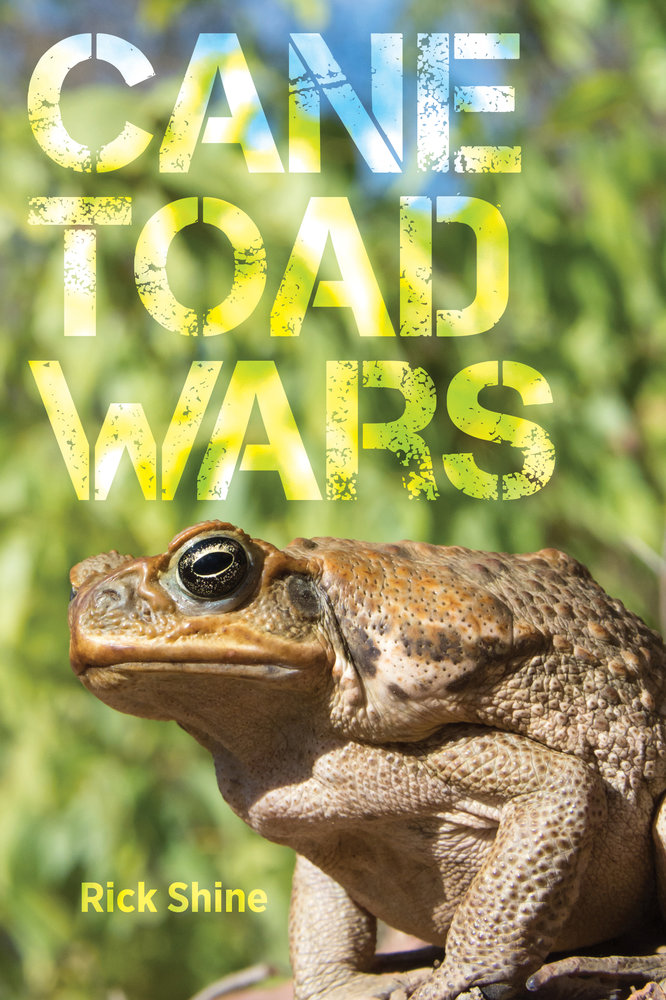
For the full story about the cane toad invasion of Australia, and what we can do about it, read Rick’s new book “Cane Toad Wars” (published by University of California Press, 2018). The book is written for the general public, not for scientists, and is aimed at a wide audience. The book can be purchased through online bookstores like Amazon, or you can buy a copy through your local bookstore.
